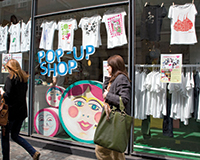 When We Are Pop Up fell into administration last month, chief executive Nicholas Russell was bombarded with the same questions: “What happened?” “If you couldn’t do it, should I stop?”
When We Are Pop Up fell into administration last month, chief executive Nicholas Russell was bombarded with the same questions: “What happened?” “If you couldn’t do it, should I stop?”
Russell was one of the first major players to enter the pop-up ring. He was also one of the first to be knocked out. His platform floundered when it failed to find new equity from investors. Last week it was bought by Dutch proptech company Real Estate Partners, which will expand the platform across Europe.
Despite being one of the first players to exit the market, Russell believes the sector has a future, but says there are a number of issues which need to be resolved.
“We have not yet seen the winning formula,” he says. “Will the pop-up market emerge as its own business model, or is this an indication that the business model needs to be fundamentally rethought?”
One of the main issues the pop-up market has to contend with is hefty overheads. The cost of rent, wages, fit-out and advertising fees associated with running a pop-up shop comes to around £15,000 a month. Given that the average sale price point for an item in a pop-up shop is £40, retailers are then under pressure to sell as many as 1,000 items a day.
“The maths just doesn’t work out,” says Russell.
Keeping sales volumes at such a high velocity as an individual operation is hard to do. Russell admits that of the few complaints he had from vendors, most of them were because they were not selling enough.
Another warning sign is that there is still no dominant player. “We have not seen that winning competitor which has been able to attract capital left, right and centre,” Russell says.
Whereas other start-ups have clear dominating players, such as Uber in the transport sector and Airbnb for accommodation, there is still no global pop-up equivalent, says Russell.
He suggests that more attention should be paid to how the pop-up sector mirrors movements in the wider retail market.
“Pop-ups work much better in a cluster,” he says. “If you scale it down it is like a micro-environment for the retail world – the food does well, the brands do well, but if you are starting the brand to reach the market then it is tough.”
Russell believes to create pop-ups that work, the model needs to form part of a wider consumer experience and become a destination in its own right, in a similar vein to how shopping centres are focusing on becoming leisure destinations rather than just shopping malls. The first step to doing this is moving the responsibility for infrastructure from the tenant to the landlord.
“People are not shopping at individual brands, they are shopping at destinations. The people that will win at this are those that start packaging pop-up with infrastructure. The serious problem with pop-up space is that most landlords do not offer this,” says Russell.
Successful pop-up destinations such as Boxpark in Shoreditch, E1, and London Union’s Street Feast, E8, provide basic shop fit-out, marketing and customers, which is a much more viable model for tenants.
When renting an empty shop for a pop-up, it is much harder to make it work on your own without the added infrastructure. Choosing where it will work without the support from other retailers is another challenge.
“There needs to be much better data about where retailers should go,” says Russell. “There needs to be some kind of mechanism telling people where they will be successful as footfall is no longer indicative.”
Landlords need to think more about how they are working with pop-ups too. Russell believes that one of the ways in which pop-ups will be able to work best is if they complement an existing retail destination, such as a department store.
“Landlords need to think about what they are doing,” he says. “The reality of making this work is that there is a loss-leader somewhere and then you make money.
“This is not a money-maker, it is about what you do with the space. Once you have brought in the experience element, you can think about where you will make your upside.”
To send feedback, e-mail amber.rolt@estatesgazette.com or tweet @AmberRoltEG or @estatesgazette











